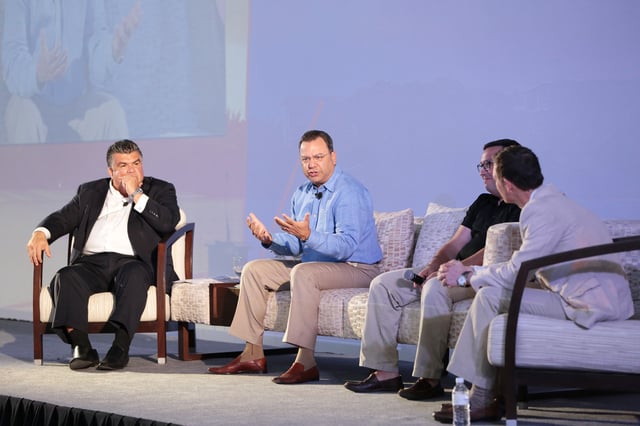3 CIOs Explain How They’ve Become Truly Agile

At Softtek’s Digital Innovation Conference earlier this year, I moderated a panel of an impressive group of CIOs and thought leaders to discuss how they are approaching the journey to enable enterprise agility.
Vic Bhagat, Former EVP and CIO of EMC and formerly of GE; Steve Fernandez, CIO of strategic medical communications services firm Conisus; and Jose Antonio Guereque, CIO of Arca Continental, the 2nd largest Coca-Cola bottler in Latin America and owner of the Wise snacks brand in the U.S., joined each other on stage to discuss how to transform their businesses into truly agile IT organizations.
Following are some of the highlights from the conversation.
1. You need agility, not just a digital strategy
Bhagat, formerly of EMC and GE, made the important observation that digital strategy doesn’t really make a lot of sense if the business does not have a strategy to survive in the digital world.
“You can have all the digital strategy you want, but if you don’t have the agility to deliver things faster, learn faster, fail fast,” then your digital strategy won’t make much difference.
If a CMO asks his CIO for a strategic app and says: “Give me 10 million dollars, 24 months, I’ll build you the best app,” that won’t work, especially if you have to launch in six months!
2. Provide regional autonomy for quick wins
Guereque, who presides over the technology initiatives for multi-national soft drink bottler Arca, said that decentralizing authority down to the geographies is crucial.
“Nowadays every single country inputs their own ideas in a centralized decision-making [system],” said Guereque. “…that way each single country director [can have] quick wins.” By providing local autonomy the company creates faster business results, can communicate quicker and can innovate in real-time in order to respond to the market.
3. Rely on partners when budgets are small and you have limited staff
But what if you don’t have the resources of a large multi-national corporation? Fernandez of Conisus said that’s when he decided it was best to rely on a third-party technology provider.
“…When you bring in a company that has all the background, the deep experience…you don’t need to buy it…[they] become my build and run shop…without putting in the large-scale investment.”
Being small(ish) has other advantages as well. “Now in a mid-sized company, within two months I was able to move our full portfolio to the cloud. I don’t own a server inside of my building any more,” said Fernandez, who is a former CIO of Coca Cola North America.
4. Take care of the basics to focus on innovation
Fernandez also emphasized the importance of handling the “keeping the lights on” activities in order to free up time and resources to focus on innovation. “…the cool thing is, in a medium-sized company, once you get that done, then we start talking about, how do we start building new things to connect with our customers?”
An important part of this is shedding the risk-averse nature of large corporations: if you’re risk-averse, you can’t innovate, emphasized Fernandez.
5. Hire proactive, innovative people
But innovation and agility isn’t just a change you apply to your current organization. It’s something you need to hire for, and unfortunately not everybody is up for the task. Bhagat observed that he’s looking for people who aren’t satisfied to just fulfill their job description – he wants to hire people who will go beyond what they’re expected.
His advice to potential new hires? “Bring your personality, bring your attitude, bring your energy into it and drive that change.”
6. Focus on making customers’ lives easier
In the book The Mobile Mind Shift: Engineer Your Business to Win in the Mobile Moment,” co-authors Ted Schadler, Josh Bernoff and Julie Ask said we’re living in the age of the customer – and that your best app strategy is to look at all those moments of inconvenience your customers face and determine how you can make their lives easier.
Bhagat provided a poignant story from his life to illustrate this point. Once when returning from an overseas trip to India with his 4-year old son, he had to take some time at the airport to connect his laptop to the company’s VPN to approve dozens of POs. But his son had wanted him to take him to the child’s play area at the airport. He approved the POs, but lost a critical father-son moment.
That experience led him to decide he’d do whatever it took to “miniaturize” applications to do things like approve POs on their phones.
“[Your customers] want it easy…they don’t want to know how many disk drives I got to buy, how many servers I have to do or what virtualization I have to do or my data center is collapsing. They don’t care.”
Conclusion
The CIOs and CTOs gathered at our conference were unanimous in their recommendations: IT organizations must become agile. Whether you’re a large firm or a mid-sized firm, there are similar challenges. You might have all the resources you need at your fingertips, as a Fortune 500 company would, or you may have a very lean department.
But agility is a must – and it starts with your customer, and cascades down to your culture and your people.



